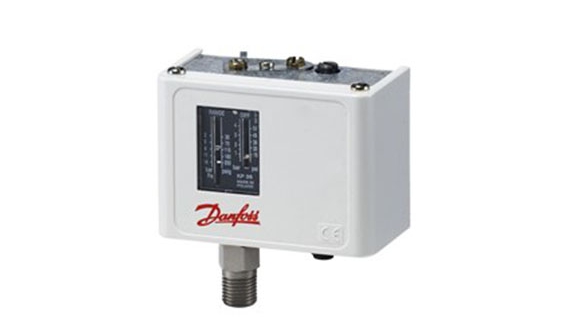Pressure switch – Thermostat KP DANFOSS
Thermostat KP DANFOSS
The KP Thermostats are single-pole, double-throw (SPDT) temperature-operated electric switches. They can be connected directly to a single-phase AC motor of up to approx. 2 kW or installed in the control circuit of DC motors and large AC motors. The KP Thermostats are used for regulation, but can also be seen in safety monitoring systems. They are available with vapour charge or with adsorption charge. With a vapor charge, the differential is very small. The KP Thermostats with adsorption charge are widely used to give frost protection.
Features
- Wide regulating range
- Can be used for deep freeze, refrigeration, and air conditioning plant
- Welded bellows elements mean increased reliability
- Small dimensions. Easy to install in refrigerated counters or cold rooms
- Ultra-short bounce times. This gives long operating life, reduces wear to a minimum and increases reliability
- Standard versions with a changeover switch. Possible to obtain opposite contact function or to connect a signal
- Electrical connection at the front of the unit. Facilitates rack mounting Saves space
- Suitable for alternating and direct current
- Cable entry of soft thermoplastic for cables from 6 to 14 mm diameter
- Extensive and wide range
Technical data
Ambient temperature
- -40 – 65 °C (80 °C for max. 2 hours)
Switch
- Single-pole, double-throw (SPDT) changeover switch
Contact load
Alternating current
- AC1 =16 A, 400 V
- AC3 = 16 A, 400 V
Direct current
- DC13: 12 W, 220 V control current
Wire dimensions
solid / stranded
- 0.75 – 2.5 mm2
flexible, without ferrules
- 0.7 – 2.5 mm2
flexible, with ferrules
- 0.5 – 1.5 mm2
Tightening torque
- max. 2 Nm
Rated impulse voltage
- 4 kV
Pollution degree
- 3
Short circuit protection, fuse
- 16 A
Insulation
- 400 V
Enclosure
- 30/44
Pressure switch KP DANFOSS
KP pressure switches are for use in refrigeration and air conditioning systems to give protection against excessively low suction pressure or excessively high discharge pressure. KP pressure switches are also used for starting and stopping refrigeration compressors and fans on air-cooled condensers. A KP pressure switch can be connected directly to a single-phase AC motor of up to approx. 2 kW or installed in the control circuit of DC motors and large AC motors.
KP pressure switches are fitted with a single-pole double-throw (SPDT) switch. The position of the switch is determined by the pressure switch setting and the pressure at the connector. KP pressure switches are available in IP30, IP44, and IP55 enclosures.
Features
- Ultra-short bounce time thanks to snap-action function (reduces wear to a minimum and increases reliability)
- Manual trip function (electrical contact function can be tested without the use of tools)
- Types KP 6, KP 7 and KP 17 with fail-safe double bellows element
- Vibration and shock-resistant
- Compact design
- Fully welded bellows element
- High reliability both electrically and mechanically
Technical data
Ambient temperature
- -40 – 65 °C (80 °C for max. 2 hours)
Ambient temperature (PED approved units)
- -25 – 65 °C (80 °C for max. 2 hours)
Media temperature
- -50 – 100 °C
Max. working pressure
- LP: PS / MWP = 17 bar
- HP: PS / MWP = 35 bar
- KP 6: PS / MWP = 46.5 bar
Max. test pressure
- LP: Pe = 20 bar
- HP: Pe = 35 bar
- KP 6: Pe = 46.5 bar
Contact load
Alternating current
- AC1 =16 A, 400 V
- AC3 = 16 A, 400 V
- AC15 = 10 A, 400 V
Direct current
- DC13 = 12 W, 220 V control current
Wire dimensions
solid / stranded
- 0.75 – 2.5 mm2
flexible, without ferrules
- 0.7 – 2.5 mm2
flexible, with ferrules
- 0.5 – 1.5 mm2
Tightening torque
- max. 2 Nm
Rated impulse voltage
- 4 kV
Pollution degree
- 3
Short circuit protection, fuse
- 16 A
Insulation
- 400 V
Enclosure
- IP30 / IP44 / IP55




Leave a Reply
Want to join the discussion?Feel free to contribute!